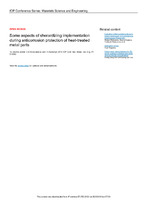| dc.contributor.author | Konstantinov, V. M. | |
| dc.contributor.author | Buloichyk, I. A. | |
| dc.date.accessioned | 2018-03-15T17:11:14Z | |
| dc.date.available | 2018-03-15T17:11:14Z | |
| dc.date.issued | 2015 | |
| dc.identifier.citation | Konstantinov, V. M. Some aspects of sherardizing implementation during anti-corrosion protection of heat-treated metal parts / V. M. Konstantinov, I. A. Buloichyk // International Scientific Conference Of Young Scientists: Advanced Materials In Construction And Engineering. – 2015. – – Vol. 71, № 012063. – (IOP Conference Series-Materials Science and Engineering) – DOI: 10.1088/1757-899X/71/1/012063. | en |
| dc.identifier.uri | https://rep.bntu.by/handle/data/38762 | |
| dc.description.abstract | The article reveals the peculiarities of obtaining Zn anticorrosive diffusion layers on heat-treated metal parts using sherardizing method. It is shown that sherardizing processes can be successfully used as a final heat treatment operation for some metal parts after hardening in a temperature gap between 350-700 degrees C. 380-450 degrees C. are the most efficient temperatures of sherardizing process to reveal hardening stresses in details. At the same time, applying sherardizing method for anticorrosive protection of details subjected to final heat treatment may cause a weakening of metal accomplished by a reduction of working properties. This fact can be described by structural changes in metal caused by additional heat impact of sherardizing temperatures. | en |
| dc.language.iso | en | en |
| dc.title | Some aspects of sherardizing implementation during anti-corrosion protection of heat-treated metal parts | en |
| dc.type | Working Paper | ru |
| dc.identifier.doi | DOI: 10.1088/1757-899X/71/1/012063 | |

